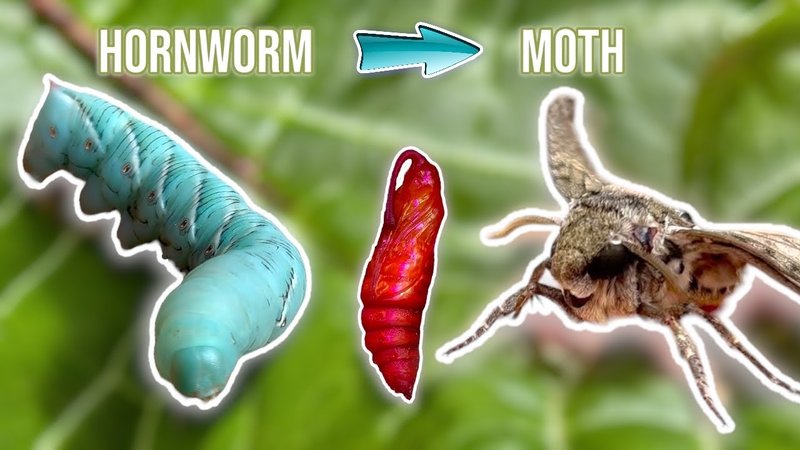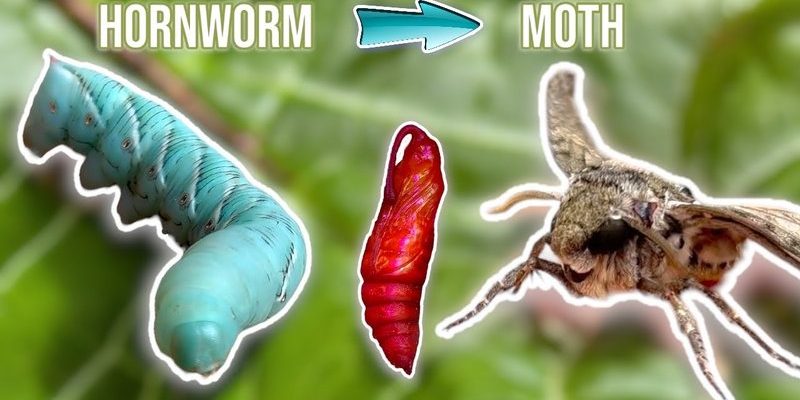
Picture this: You’ve planted a beautiful vegetable garden, and suddenly, you spot one of these green giants. You might think, “How on earth did that get so big so quickly?” That’s the magic of hornworms. Understanding their growth process not only satisfies curiosity but can also help gardeners manage these pests—either by controlling their population or learning to coexist with them. In this article, we’ll explore the ins and outs of hornworm growth, so you can appreciate these creatures and protect your garden.
The Life Cycle of Hornworms
To grasp how fast hornworms grow, it’s essential to understand their life cycle. Hornworms undergo **complete metamorphosis**, which means they go through four distinct stages: egg, larva (the caterpillar stage), pupa, and adult moth. The entire cycle can take just a few weeks, depending on environmental factors like temperature and food availability.
1. **Egg Stage:** The journey begins when the female **sphinx moth** lays her eggs, which are tiny and often hidden on the underside of leaves. Each moth can lay up to 200 eggs, which are roughly the size of a pinhead. After a few days, the eggs hatch into larvae, and that’s when the real action starts.
2. **Larval Stage:** This is when hornworms really show their growth potential. Upon hatching, these caterpillars are just a few millimeters long, but they quickly become voracious eaters. In roughly 2-3 weeks, they can grow to be around 4 inches long, thanks to their insatiable appetite for leaves and stems.
3. **Pupa Stage:** After a few weeks of eating, the hornworm will find a safe spot to pupate. It’ll burrow into the soil or find a sheltered area, where it transforms into a pupa. This stage can last from a week to several months, depending on conditions.
4. **Adult Moth:** Finally, the pupae break open, revealing a beautiful adult sphinx moth. These moths can emerge as early as a week after pupation, quickly continuing the cycle by laying more eggs.
Understanding this life cycle highlights just how fast hornworms grow, especially during that larval stage!
Factors Affecting Hornworm Growth Rate
You might be wondering what really drives the growth of hornworms. Several factors can influence how fast they develop, including temperature, food access, and humidity.
1. **Temperature:** Hornworms thrive in warm weather, typically between 70°F and 85°F. In such ideal conditions, they can grow at incredible rates. However, if the temperature drops too low, their growth will slow down significantly.
2. **Food Supply:** A steady diet of leaves—especially from tomato or tobacco plants—fuels their growth. The more they eat, the faster they grow. If these plants aren’t within reach, or if they’re over-harvested, the hornworms won’t reach their full size.
3. **Humidity:** High humidity levels can also promote quicker growth. When it’s moist, hornworms tend to feed more, aiding their rapid development. Too dry, and they may struggle to thrive.
By considering these factors, gardeners can better understand how quickly hornworms might grow in their own environments.
How to Identify Hornworms
Identifying hornworms isn’t too tricky, especially if you know what to look for. These caterpillars are generally bright green with white markings, making them blend in well with tomato leaves.
1. **Size and Shape:** Mature hornworms can reach about 4 inches long. They have a distinctive curled tail, which gives them a characteristic horn-like appearance.
2. **Color and Markings:** The bright green color helps them camouflage against plant foliage. You can often spot white or yellow stripes along their bodies, which can serve as a warning to potential predators.
3. **Frass:** Look for signs of damage in your garden. If you see leaves with distinct holes, or find dark green droppings (known as frass) scattered around, there’s a good chance you’ve got a hornworm lurking nearby.
Understanding how to identify hornworms can save your plants from unexpected damage while helping you monitor their growth.
Managing Hornworm Populations
If you’re a gardener, you might find yourself in a battle with these fast-growing caterpillars. They can do significant damage to your plants if not addressed quickly. Here’s how to manage hornworm populations effectively:
1. **Handpicking:** One of the simplest ways to manage hornworms is to pick them off your plants by hand. Wearing gloves, you can easily remove them and relocate or dispose of them.
2. **Natural Predators:** Encourage natural predators like birds and parasitic wasps, which feed on hornworms. Planting flowers that attract these beneficial creatures can help keep the hornworm population in check.
3. **Organic Treatments:** If the infestation is severe, you can use organic sprays made from neem oil or insecticidal soap. These can be effective in controlling hornworms without harming beneficial insects.
By staying proactive and using these methods, you can manage hornworm growth and protect your cherished garden.
Health Benefits of Hornworms
While hornworms are often seen as pests, they also present some surprising advantages. For instance, hornworms serve as an important food source for various birds and other wildlife. This makes them a crucial part of the ecosystem, supporting the food chain and helping maintain balance in your garden.
Moreover, some people cultivate hornworms for feeding pet reptiles and amphibians. They’re a nutritious option, packed with protein and fat, making them an excellent choice for anyone who keeps such pets.
Additionally, hornworms can become subjects of study in biology classes. They are often used to teach students about metamorphosis and the life cycle of insects.
So, while it’s easy to see them as mere pests, hornworms contribute to broader ecological and educational purposes.
Hornworms are incredible little creatures that grow rapidly from eggs to large caterpillars, reaching impressive sizes in just a few weeks. Understanding how fast they grow involves appreciating their life cycle and recognizing the factors that influence their development. While these critters can damage your garden, adopting smart management strategies can help coexist with them.
So, next time you spot a hornworm in your garden, take a moment to observe its growth. They’re not just pests; they’re part of the fascinating journey of nature, evolving right before our eyes. Happy gardening!

